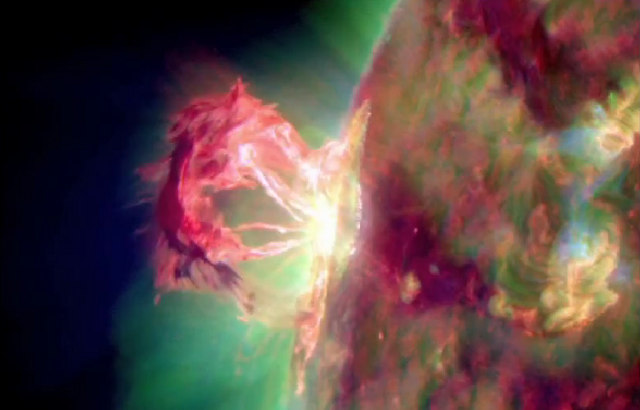It is possible that a superflare could happen from our Sun, and if Earth is in the line of fire, it could very well end the world.
“We certainly did not expect to find superflare stars with magnetic fields as weak as the magnetic fields on the Sun. This opens the possibility that the Sun could generate a superflare – a very frightening thought” says Christoffer Karoff a leading expert in the internal structure of the Sun and its activity at Denmark’s Aarhus University. “If an eruption of this size was to strike the Earth today, it would have devastating consequences. Not just for all electronic equipment on Earth, but also for our atmosphere and thus our planet’s ability to support life.”
When the Sun pours out gigantic amounts of hot plasma during the large solar eruptions, it may have severe consequences on Earth. Solar eruptions are, however, nothing compared to the eruption we see on other stars, the so-called ‘superflares’. Superflares have been a mystery since the Kepler mission discovered them in larger numbers four years ago.
Questions arose: Are superflares formed by the same mechanism as solar flares? If so, does that mean that the Sun is also capable of producing a superflare? An international research team led by Karoff from Aarhus University, Denmark, has now provided answers to some of these questions.
On 1 September 1859, astronomers observed how one of the dark spots on the surface of the Sun suddenly lit up and shone brilliantly over the solar surface. This phenomenon had never been observed before and nobody knew what was to come. On the morning of September 2, the first particles from, what we now know was an enormous eruption on the Sun, reached the Earth.
The 1859 solar storm is also known as the “Carrington Event”. Auroras associated with this event could be seen as far south as Cuba and Hawaii, telegraph system worldwide went haywire, and ice core records from Greenland indicate that the Earth’s protective ozone layer was damaged by the energetic particles from the solar storm.
The cosmos, however, contains other stars and some of these regularly experience eruptions that can be up to 10.000 times larger than the Carrington event.
Solar flares occur when large magnetic fields on the surface of the Sun collapse. When that happens, huge amounts of magnetic energy are released. Christoffer Karoff and his team have use observations of magnetic fields on the surface of almost 100.000 stars made with the new Guo Shou Jing telescope in China to show that these superflares are likely formed via the same mechanism as solar flares.
“The magnetic fields on the surface of stars with superflares are generally stronger than the magnetic fields on the surface of the Sun. This is exactly what we would expect, if superflares are formed in the same way as solar flares” explains Karoff.
It does therefore not seem likely that the Sun should be able to create a superflare, its magnetic field is simply to weak. However…Out of all the stars with superflares that Karoff and his team analyzed, around 10% had a magnetic field with a strength similar to or weaker than the Sun’s magnetic field. Therefore, even though it is not very likely, it is not impossible that the Sun could produce a superflare.
Evidence from geological archives has shown that the Sun might have produced a small superflare in AD 775. Here, tree rings show that anomalously large amounts of the radioactive isotope 14C were formed in the Earth’s atmosphere. 14C is formed when cosmic-ray particles from our galaxy, the Milky Way, or especially energetic protons from the Sun, formed in connection with large solar eruptions, enter the Earth’s atmosphere.
“One of the strengths of our study is that we can show how astronomical observations of superflares agree with Earth-based studies of radioactive isotopes in tree rings.” explains Karoff.
In this way, the observations from the Guo Shou Jing telescope (above) can be used to evaluate how often a star with a magnetic field similar to the Sun would experience a superflare. The new study shows that the Sun, statistically speaking, should experience a small superflare every millennium. This is in agreement with idea that the event in AD 775 and a similar event in AD 993 were indeed caused by small superflares on the Sun.
It is no coincidence that the new Guo Shou Jing telescope in China was used for this study. In order to measure the magnetic fields, Christoffer Karoff and his team used a spectrum for every star of the 100.000 stars available for this analysis. A spectrum shows the colors, or wavelengths, of the light from the stars. Here, certain short ultraviolet wavelengths can be used to measure the magnetic fields around the stars.
The problem is, however, that conventional telescopes are only capable of obtaining one spectrum of a single star at a time. Therefore, if the observations were to be made with another telescope, such as the Nordic Optical Telescope on La Palma – a telescope the research group has used before – it would require 15-20 years of continuous observations.
The Guo Shou Jing telescope, or LAMOST as it is also called, is optimized for obtaining spectra of up to 4.000 stars simultaneously, as 4.000 optical fibers are connected to the telescope. This makes it possible to observe 100.000 stars in only a few weeks and it is this special capability that has made it possible to generate the new results.
Source: The Daily Galaxy
































Leave a Comment
You must be logged in to post a comment.